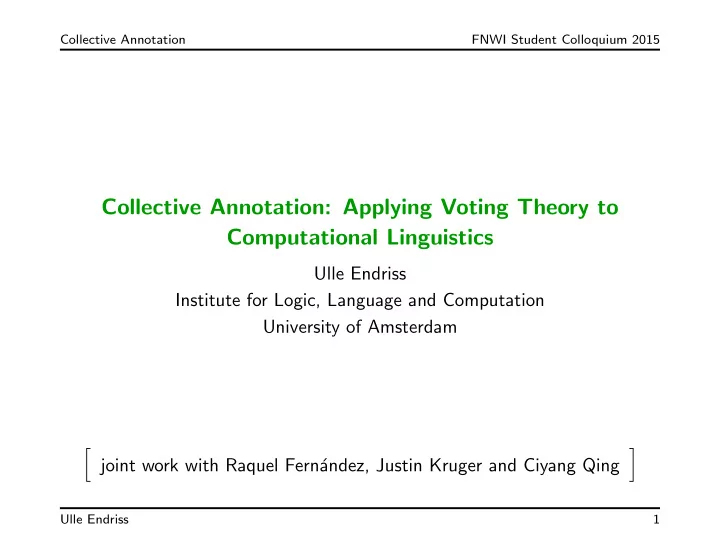

Collective Annotation FNWI Student Colloquium 2015 Collective Annotation: Applying Voting Theory to Computational Linguistics Ulle Endriss Institute for Logic, Language and Computation University of Amsterdam � � joint work with Raquel Fern´ andez, Justin Kruger and Ciyang Qing Ulle Endriss 1
Collective Annotation FNWI Student Colloquium 2015 Students Involved Justin Kruger (Master of Logic 2014) ◮ Bachelor Philosophy, University of St Andrews, 2011 ◮ Now: PhD Computer Science and Decision Analysis, Paris-Dauphine University Ciyang Qing (Master of Logic 2014) ◮ Bachelor Computer Science, Peking University, 2012 ◮ Now: PhD Linguistics & Cognitive Science, Stanford University Ulle Endriss 2
Collective Annotation FNWI Student Colloquium 2015 Challenge: Annotation for Linguistics Imagine a researcher in computational linguistics, working on designing a new voice-controlled personal assistant, wants to understand what distinguishes rhetorical questions from other kinds of questions . . . They will need a lot of annotated data , like this: B: [Noise] Yeah. B: It, it’s one of those necessities of life that we all have to, you know, pay taxes but, although it is kind of a pain sometimes though. A: It’s just scary though about, you know. — A: How high are the taxes going to be when my children are my age? B: Uh-huh. A: You know, that, that’s, that’s scary too. Yes-No � Wh � Declarative � Rhetorical � Ulle Endriss 3
Collective Annotation FNWI Student Colloquium 2015 Collecting Raw Annotations: Crowdsourcing Ulle Endriss 4
Collective Annotation FNWI Student Colloquium 2015 Idea: Collective Annotation as Social Choice Aggregating information from individuals is what social choice theory is all about. Classical case: aggregation of preferences in an election. F : vector of individual preferences �→ election winner F : vector of individual annotations �→ collective annotation Ulle Endriss 5
Collective Annotation FNWI Student Colloquium 2015 Example: Estimating Accuracy as Agreement Na¨ ıve approach: majority voting . We have developed several more sophisticated aggregation rules. Here is one: (1) Assume annotator i makes correct choice with probability p i , and each of the wrong choices with equal probability (1 − p i ) / ( k − 1) . (2) Use weighted majority voting , giving more weight to annotators i with higher accuracy p i . How much more? Maximum likelihood for: weight i = log ( k − 1) · p i 1 − p i Great . . . except that actually we don’t know any of the p i ’s! (3) But we can try to estimate the accuracy p i of annotator i as her observed agreement with the simple majority rule : p i ≈ # items where i and majority rule agree + 0 . 5 # items annotated by i + 1 Ulle Endriss 6
Collective Annotation FNWI Student Colloquium 2015 Results Majority voting with 10 annotations per item achieves 85% accuracy , relative to an existing corpus annotated manually by experts. Our rule achieves the same accuracy with just 6 annotations per item. For more rules, results, our papers, and our crowdsourced data, see: http://www.illc.uva.nl/Resources/CollectiveAnnotation/ U. Endriss and R. Fern´ andez. Collective Annotation of Linguistic Resources: Basic Principles and a Formal Model. Proc. ACL-2013. J. Kruger, U. Endriss, R. Fern´ andez, and C. Qing. Axiomatic Analysis of Aggre- gation Methods for Collective Annotation. Proc. AAMAS-2014. C. Qing, U. Endriss, R. Fern´ andez, and J. Kruger. Empirical Analysis of Aggrega- tion Methods for Collective Annotation. Proc. COLING-2014. Ulle Endriss 7
Recommend
More recommend